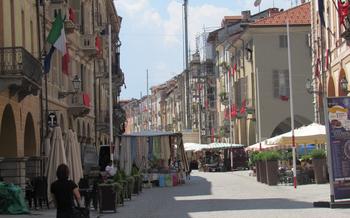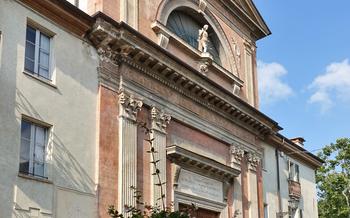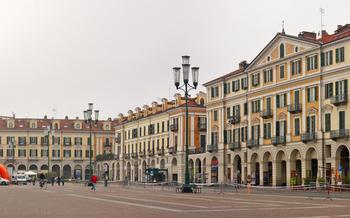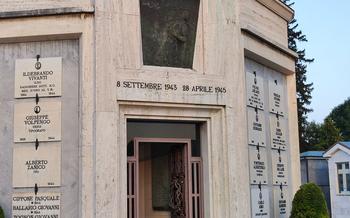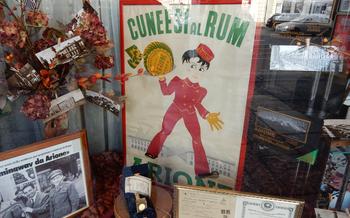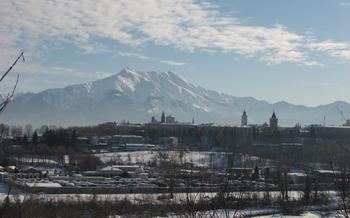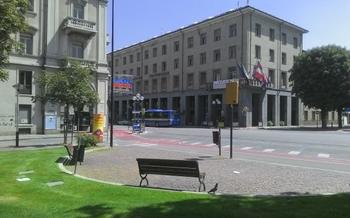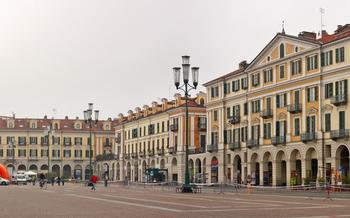
Cantina Oddero
- Introduction
- A Family Tradition
- Grapes and Terroir
- Theoretical Notions
- Practical Suggestions
- Anecdote
- Winemaking Process
- Barolo and Other Wines
- Awards and Recognition
- Wine Tourism in Cuneo
- Food Pairing
- Local Cuisine
- Art and Culture
- Accommodations
- Transportation
- Budgeting
- Safety
Introduction
Established in 1878, nestled in the picturesque region of Barolo, Italy, Cantina Oddero stands as a true testament to the enduring legacy of winemaking in Cuneo. With a history spanning over a century, the winery has been instrumental in shaping the identity of the region's viticulture, earning a reputation worldwide for crafting wines of exceptional quality and elegance.
The Oddero family, custodians of this revered legacy, has dedicated themselves to preserving the tradition of excellence while embracing innovation and sustainability. Their commitment to minimal intervention, meticulous attention to detail, and a profound respect for the terroir have resulted in wines that are both expressive of their origins and captivating in their complexity and finesse.
A visit to Cantina Oddero promises an immersive journey into the world of Barolo and beyond. Discover the secrets behind their renowned wines, explore the tapestry of flavors that define the region, and savor the essence of Italian winemaking excellence in the heart of Cuneo.
A Family Tradition
The Oddero family has been crafting wines in the rolling hills of Cuneo for four generations, their passion and dedication passed down from father to son. Guided by the philosophy of minimal intervention and respect for the land, they strive to produce wines that faithfully express the unique terroir of the region.
Their commitment to quality begins in the vineyards, where sustainable viticulture practices are employed to nurture healthy grapes. The meticulously selected grapes are then harvested by hand at the optimal moment of ripeness, ensuring the preservation of their aromatic complexity and flavor intensity.
With a deep understanding of the delicate balance between tradition and innovation, the Odderos expertly blend traditional winemaking methods with modern techniques. Each step of the winemaking process, from fermentation to aging, is carefully monitored to ensure the highest standards of quality and consistency.
To fully immerse yourself in the Oddero family's winemaking journey, book a visit to their historic winery. Choose from a variety of guided tours that delve into the intricacies of their winemaking process, providing insights into the passion and dedication that goes into each bottle.
During your visit, you'll have the opportunity to explore the vineyards, learn about the grape varieties cultivated, and witness the winemaking process firsthand. The tour concludes with a tasting of their exceptional wines, a chance to savor the fruits of the Oddero family's labor and experience the essence of Cuneo in every sip.
One memorable visit to the winery that stands out in my mind occurred during the harvest season. I had the privilege of joining the Oddero family in the vineyards, witnessing their meticulous attention to detail as they handpicked the ripe grapes. The atmosphere was electric with anticipation as they carefully selected each bunch, ensuring only the finest grapes made their way into their wines.
As we worked alongside the Odderos, they shared stories of their family's history, their passion for winemaking, and their unwavering commitment to crafting wines that reflect the true character of Cuneo. The experience left an indelible mark, deepening my appreciation for the dedication and craftsmanship that goes into every bottle of Oddero wine.
Grapes and Terroir
Theoretical Notions
The vineyards of Cuneo are located in a unique microclimate, with warm days and cool nights that allow the grapes to ripen slowly and develop their full flavor. The soil is composed of limestone, clay, and marl, which provide excellent drainage and allow the vines to access deep mineral deposits. These conditions, combined with the skill and experience of the Oddero family, result in grapes of exceptional quality.
Oddero grows a variety of grape varieties, including Nebbiolo, Barbera, and Dolcetto. Nebbiolo is the most important variety in the region and is used to produce Barolo, one of Italy's most prestigious wines. Barbera is a red grape that produces wines with lively acidity and dark fruit flavors, while Dolcetto is a black grape that produces light, fruity wines that are meant to be enjoyed young.
Practical Suggestions
You can learn about the different vineyards and grape varieties by visiting the Oddero winery website or taking a guided tour of the estate. The winery offers a range of tours, including a basic tour of the vineyards and cellars, a more in-depth tour that includes a tasting of several wines, and a private tour that can be customized to your interests.
When choosing a wine, it is important to consider your personal preferences. If you prefer light, fruity wines, then a Dolcetto or Barbera may be a good choice. If you prefer more structured wines with aging potential, then a Barolo or Barbaresco may be a better option.
Anecdote
During my visit to the Oddero winery, I had the opportunity to taste a number of different wines, including a Barolo from the 2016 vintage. This wine was still young, but it showed great potential. It had a deep ruby color, a complex nose of red fruit, tar, and roses, and a long, elegant finish. I was very impressed with this wine and I am looking forward to seeing how it develops over the next few years.
Winemaking Process
Barolo and the other wines of Oddero are made using traditional methods that have been passed down from generation to generation and, at the same time, continuously enriched with the most modern technologies. The grapes are harvested by hand to ensure that only the ripest and healthiest bunches are selected. After destemming and crushing, the grapes are fermented in temperature-controlled stainless steel tanks for about 15 days. During fermentation, the wine is punched down several times a day to extract color and tannins from the skins.
Once fermentation is complete, the wine is aged in a combination of large oak barrels and smaller French oak barriques for a period of 18 to 36 months, depending on the type of wine. During aging, the wine undergoes malolactic fermentation, which softens the acidity and adds complexity to the flavor. After aging, the wine is bottled and left to rest for a further period of time before being released for sale.
Oddero's commitment to quality is evident in every step of the winemaking process. The wines are carefully monitored throughout their development to ensure that they meet the highest standards. This attention to detail has resulted in a range of wines that are consistently praised by critics and wine lovers around the world.
Practical suggestions:
- Visitors to the Cantina Oddero can learn about the winemaking process by taking a guided tour of the winery. Tours are available by reservation and typically last for about an hour.
- During the tour, visitors will see the different stages of the winemaking process, from harvesting to aging and bottling.
- Visitors will also have the opportunity to taste the wines at different stages of their development, including a barrel tasting of young wines.
Anecdote:
During a recent visit to the Cantina Oddero, I had the opportunity to taste a barrel sample of the 2019 Barolo. The wine was still young, but it already showed great promise. The fruit was ripe and concentrated, with hints of spice and tar. The tannins were firm but well-integrated, and the acidity was balanced. I can't wait to taste the finished wine when it is released in a few years.
Barolo and Other Wines
Theoretical notions: The winery produces a wide range of wines, including Barolo, Barbaresco, and Dolcetto d'Alba. Barolo, made from the Nebbiolo grape, is the region's most famous wine. It is known for its complex aromas and flavors of red fruit, licorice, tar, and roses. Barolo is a long-lived wine, and it can age for decades in the bottle.
Oddero's Barolo is produced from grapes grown in the communes of Serralunga d'Alba and Castiglione Falletto. The wine is aged for at least 36 months in large oak barrels, and then for a further 24 months in bottle. The result is a wine with a deep, garnet color and a complex bouquet of aromas and flavors.
In addition to Barolo, Oddero also produces Barbaresco, which is another Nebbiolo-based wine from the nearby Langhe region. Barbaresco is typically lighter in body and higher in acidity than Barolo, and it is often said to be more elegant and feminine.
The winery also produces a number of other wines, including Dolcetto d'Alba, Nebbiolo d'Alba, and Chardonnay. These wines are all made from grapes grown in the Cuneo area, and they reflect the unique terroir of the region.
Practical suggestions: When choosing a Barolo, there are a few things to keep in mind. First, consider the vintage. Barolo is a long-lived wine, and it can age for decades in the bottle. However, some vintages are better than others. Some of the best vintages for Barolo in recent years include 2016, 2015, and 20
Second, consider the producer. There are many excellent producers of Barolo, and Oddero is one of the best. The winery's Barolo is consistently praised by critics for its complexity, elegance, and aging potential.
Finally, consider the price. Barolo is a premium wine, and it can be expensive. However, there are a number of good value Barolos available. Oddero's Barolo is priced at around $80 per bottle, which is a reasonable price for a wine of this quality.
Anecdote: A few years ago, I had the opportunity to taste a bottle of Oddero Barolo from the 2010 vintage. The wine was absolutely stunning. It had a deep, garnet color and a complex bouquet of aromas and flavors. On the palate, the wine was full-bodied and velvety, with a long, lingering finish. I was so impressed by the wine that I bought a bottle to take home with me. I opened it a few weeks later to share with some friends, and it was just as good as I remembered. The wine had aged beautifully, and it was even better than it had been when I first tasted it.
Awards and Recognition
Oddero has received numerous prestigious awards and accolades over the years, solidifying its reputation as one of the leading wineries in Italy. Their Barolo wines have been particularly celebrated, earning high scores from renowned wine critics and winning numerous awards at international competitions. In 2021, Oddero's Barolo Vigna Rionda 2016 was awarded 100 points by James Suckling, making it one of the highest-rated Barolos of the vintage. The winery has also been recognized for its commitment to sustainable viticulture and winemaking practices, receiving several awards for its environmental initiatives.
These awards and recognitions serve as a testament to the exceptional quality and consistency of Oddero's wines. When choosing a bottle of Oddero wine, you can be confident that you are getting a world-class wine that has been crafted with passion and dedication. The winery's impressive track record of success is a reflection of the Oddero family's commitment to excellence and their unwavering commitment to producing wines that are both delicious and age-worthy.
Anecdote
In 2019, I had the opportunity to attend a wine tasting event where I sampled several of Oddero's award-winning Barolos. I was particularly impressed by the 2013 Barolo Vigna Loreto, which had a complex and elegant bouquet with notes of red fruits, dried roses, and tar. The palate was full-bodied and structured, with velvety tannins and a long, lingering finish. This wine was a true testament to the skill and dedication of the Oddero family, and it was an honor to taste such an exceptional wine.
Wine Tourism in Cuneo
In recent years, wine tourism has become increasingly popular in Cuneo, and Oddero has played a significant role in promoting the region. The winery offers a variety of tours and experiences that allow visitors to learn about the winemaking process, taste the wines, and explore the beautiful vineyards.
Practical suggestions:
- To plan a wine tour in Cuneo, you can visit the website of the Cuneo Wine Association, where you can find information about the different wineries and activities in the region.
- You can also book a guided tour through a local tour operator, which will allow you to visit several wineries in one day and learn about the history and culture of the region.
- When visiting a winery, be sure to dress appropriately, as some wineries have dress codes. It is also a good idea to make a reservation in advance, especially during the busy season.
Anecdote:
On my last visit to Cuneo, I took a guided wine tour that took me to several wineries in the region, including Oddero. I was particularly impressed by the beautiful vineyards and the knowledgeable staff at each winery. I learned a lot about the winemaking process and the different wines that are produced in the region.
I would highly recommend a wine tour in Cuneo to anyone who is interested in learning more about wine and the culture of the region. It is a great way to spend a day or two exploring the beautiful countryside and tasting the delicious wines of Cuneo.
Food Pairing
The art of food pairing is a delicate dance between flavors, textures, and aromas. When done well, it can elevate a simple meal into an unforgettable culinary experience. Here at Cantina Oddero, we take food pairing very seriously. Our knowledgeable staff is always on hand to help you choose the perfect wine to accompany your meal.
Theoretical Notions
The basic principles of food pairing are relatively simple. Start by considering the flavors of the dish you're serving. Is it sweet, savory, sour, or bitter? Once you've identified the dominant flavors, you can start to think about which wines will complement them best.
Sweet dishes, for example, pair well with sweeter wines, such as Moscato d'Asti or Brachetto d'Acqui. Savory dishes, on the other hand, call for more structured wines, such as Barolo or Barbaresco. Sour dishes can be balanced with wines that have a high acidity, such as Gavi or Arneis. And bitter dishes can be softened with wines that have a touch of sweetness, such as Recioto della Valpolicella or Amarone della Valpolicella.
Practical Suggestions
In addition to the basic principles of food pairing, there are a few other things to keep in mind when choosing a wine to serve with food.
- Consider the texture of the dish. Lighter dishes, such as salads or seafood, pair well with lighter-bodied wines. Heavier dishes, such as red meat or pasta, can handle more full-bodied wines.
- Think about the cooking method. Grilled or roasted dishes pair well with red wines that have a smoky or grilled flavor. Fried dishes pair well with white wines that have a crisp acidity.
- Don't be afraid to experiment. There are no hard and fast rules when it comes to food pairing. The best way to find out what you like is to experiment with different combinations and see what you enjoy.
Anecdote
One of my favorite food and wine pairing experiences was at a recent dinner party I hosted. I served a roasted lamb with a Barolo from the 2010 vintage. The lamb was juicy and flavorful, with a slightly gamey taste. The Barolo, with its complex aromas of red fruit, spice, and tar, was the perfect complement to the lamb. The wine's tannins helped to balance the fattiness of the lamb, and the acidity cut through the richness of the meat. It was a truly memorable meal, and I'm still dreaming about it today.
Local Cuisine
The cuisine of Cuneo is a reflection of the region's rich history and culture, with influences from neighboring Piedmont and Liguria. The local dishes are hearty and flavorful, making use of fresh, seasonal ingredients.
Among the must-try dishes in Cuneo are:
-
Risotto al Castelmagno: A creamy risotto made with Castelmagno cheese, a local specialty.
-
Brasato al Barolo: A slow-cooked beef stew braised in Barolo wine.
-
Agnolotti: Small pasta pockets filled with meat or vegetables, served with a variety of sauces.
-
Panissa: A traditional dish made with chickpeas, rice, and vegetables, similar to paella.
-
Torta di nocciole: A hazelnut cake made with local hazelnuts, a specialty of the Langhe region.
When in Cuneo, be sure to visit the local markets to sample the fresh produce and local specialties. You can also find a variety of restaurants serving traditional and modern interpretations of Cuneo cuisine.
Anecdote:
On my last visit to Cuneo, I had the pleasure of dining at a small, family-run restaurant called "La Tavernetta." The atmosphere was warm and inviting, and the food was simply delicious. I started with a plate of antipasti, which included a variety of local cheeses, meats, and vegetables. For my main course, I had the brasato al Barolo, which was melt-in-your-mouth tender. The wine list was extensive, and I was able to find the perfect bottle of Barolo to pair with my meal. Overall, it was a fantastic dining experience, and I would highly recommend La Tavernetta to anyone visiting Cuneo.
Art and Culture
Cuneo's rich cultural heritage is deeply intertwined with the history of winemaking in the region and reflected in the various forms of art, architecture, and traditions that have emerged over time.
Among the numerous museums, the Museo Egizio in Cuneo stands out as a must-visit destination. Housing an impressive collection of Egyptian artifacts, it transports visitors back to the ancient civilizations that influenced the development of winemaking in the Mediterranean region.
Through the cobbled streets of the historic center, visitors can admire the architectural masterpieces that dot the cityscape, such as the majestic Palazzo del Municipio and the striking Duomo di Cuneo. These iconic landmarks showcase the architectural prowess of the region and serve as a testament to the rich history of the city.
Immerse yourself in the vibrant local traditions by attending one of the many festivals and events that take place throughout the year. The Palio dei Borghi, a traditional horse race, is a spectacle not to be missed, where riders compete in a thrilling display of horsemanship and skill.
To truly delve into the local culture, embark on a culinary journey by savoring the delectable dishes influenced by the region's renowned wines. From hearty stews paired with robust red wines to delicate pasta dishes complemented by crisp whites, the flavors of Cuneo's cuisine are a testament to the harmonious relationship between wine and food.
As you explore the cultural tapestry of Cuneo, you'll discover a region where art, history, and wine intertwine to create a captivating and unforgettable experience.
Accommodations
Cuneo offers a wide range of accommodation options to suit all budgets and preferences. From luxurious hotels with stunning views of the surrounding countryside to cozy bed and breakfasts in the heart of the city, there's something for everyone in this charming Italian town.
For those seeking a truly unforgettable experience, the Grand Hotel Cuneo is a must-stay. This historic hotel, dating back to the early 1900s, offers elegant rooms and suites, a rooftop terrace with panoramic views, and a Michelin-starred restaurant.
For a more intimate and authentic experience, consider staying at a bed and breakfast. La Casa di Nonna Bice is a charming B&B located in the historic center of Cuneo, offering cozy rooms, a delicious breakfast, and warm hospitality.
No matter where you choose to stay, you're sure to find comfortable and welcoming accommodations in Cuneo. Be sure to book your room in advance, especially during the peak tourist season, to avoid disappointment.
Anecdote:
On my last trip to Cuneo, I had the pleasure of staying at the Locanda dell'Angelo, a small, family-run hotel located just a short walk from the city center. The hotel was charming and cozy, with friendly staff and a delicious breakfast. I especially enjoyed the hotel's rooftop terrace, where I could relax with a glass of wine and soak in the stunning views of the city and the surrounding mountains.
Transportation
Cuneo is easily accessible by various transportation means, making it a convenient destination for travelers. For those arriving by air, the nearest airport is Cuneo International Airport (CUF), located just a few kilometers from the city center. Several car rental companies operate at the airport, providing visitors with the convenience of exploring the region at their own pace.
For those traveling by train, Cuneo Train Station offers direct connections to major cities in Italy, such as Turin and Milan. The station is strategically located within walking distance of the city center, making it easy for visitors to reach their accommodations and begin their exploration.
Public transportation within Cuneo is efficient and affordable, with a network of buses connecting different parts of the city. Visitors can purchase bus tickets at designated newsstands or directly from the bus driver. Taxis are also readily available, offering a convenient option for short-distance travel.
For those seeking a more immersive experience, cycling is a popular way to explore Cuneo and its surroundings. Several bike rental shops are located throughout the city, providing visitors with the opportunity to pedal through the charming streets and picturesque countryside.
No matter the preferred mode of transportation, Cuneo is well-equipped to accommodate visitors and ensure a smooth and enjoyable travel experience.
Budgeting
Traveling to Cuneo can be as budget-friendly or as luxurious as you desire. Accommodation options range from budget-friendly hostels to luxurious hotels, with prices varying depending on the time of year and the level of comfort you seek. Food costs are also quite reasonable, with many local restaurants offering delicious meals at affordable prices. Transportation is also relatively inexpensive, with a good public transportation system and affordable car rental options.
To save money, consider visiting during the shoulder seasons (spring or fall) when prices are typically lower. Look for discounts and special offers on accommodation and activities, and take advantage of free walking tours and other budget-friendly experiences. Eating at local markets and cooking your own meals can also help you save money.
Overall, Cuneo is an affordable destination that offers good value for money. With a little planning, you can easily enjoy a memorable trip without breaking the bank.
Safety
Cuneo is generally considered a safe city for travelers. The crime rate is low, and the streets are well-lit and patrolled. However, as with any travel destination, it's important to take precautions to ensure your safety. Be aware of your surroundings, especially at night. Avoid walking alone in isolated areas, and be wary of pickpockets in crowded places. It's also a good idea to keep your valuables safe, such as your passport, money, and credit cards.
Here are some additional safety tips for travelers to Cuneo:
- Be aware of your surroundings and avoid walking alone at night.
- Keep your valuables safe, such as your passport, money, and credit cards.
- Be wary of pickpockets in crowded places.
- Don't flash your cash or other valuables in public.
- If you're lost or need help, don't hesitate to ask a local for directions or assistance.
- Learn a few basic Italian phrases, such as "hello," "goodbye," and "thank you."
- If you're traveling alone, let someone know your itinerary and check in with them regularly.
- Trust your instincts. If something feels wrong, it probably is.
